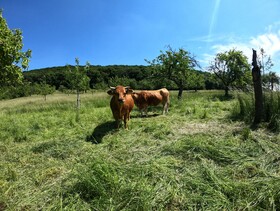


We lose soil every day and 10 times faster than it can be formed. Desertification, erosion, salinization, poisoning and building development are just a few of the decisive negative factors. Added to this is the loss of water, with 60% of groundwater supplies being consumed faster than they can be replenished by natural processes.
The Naturefund team uses ecological monitoring to measure the impact of sustainable grazing on the land. The aim is to change ecosystem processes in a positive and sustainable way. Constant observation is important in order to be able to document and classify changes as early as possible. Moreover, only in this way can necessary countermeasures be initiated. Special attention is given to the examination of the soil surface.
After only one year of regenerative grazing through holistic grazing management with our own herd of cows, we were able to record many positive observations:
A trained eye looks at the soil and sees many factors to classify it: plant spacing, mulch material, soil density, aeration, or organic matter percentages. But insect density, seedlings and the quality of water drainage are also key criteria.
According to the Savorry Institute, 7 criteria of a precisely measured area should be studied in more detail:
1. soil surface: This is the general condition of the surface between the plants. If necessary, is this uncovered, hardened, broken up, or even light and loose. The more closed the surface is the better and also loose and but not eruiered are good signs.
2. animal signs: This is about the diversity of species on the defined area. Are directly animals countable or which signs of these are to be seen. Are animal droppings or other signs of their presence visible.
3. mulch: if present, the degree of soil cover by organic material should be classified. Its classification as fresh or decayed should also be documented.
4. condition of perennial plants: plants that live nicely off this area for more than a year should be closely examined. What is their general condition? Young, mature, healthy, or depleted, color changes or even death may be characteristics. Yellow spots in the leaves, for example, may indicate nutrient deficiencies such as nitrogen deficiency. Younger plants may have been affected by recent weather processes in too short a time.
5. and 6. grass species and other plants: Also surveyed are the number of grasses. By which species is the area composed in percentage comparison.
7. points of interest are noted. e.g. whether cow dung from the last grazing can still be seen, or whether these have been completely decomposed by natural processes.